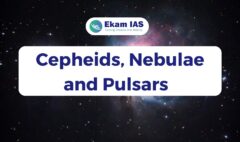International Asteroid Day and The Tunguska Event
January 4, 2023 2023-01-04 13:53International Asteroid Day and The Tunguska Event
- International Asteroid Day is observed on 30 June to raise awareness in public about the asteroid’s hazardous effect and the day marks the anniversary of the Tunguska impact over Siberia.
- The International Asteroid Day was adopted by the United Nations General Assembly through a resolution in December 2016.
What is Tunguska Impact?
- The Tunguska asteroid event in Siberia, Russian Federation, on 30 June 1908, was the Earth’s largest asteroid impact in recorded history.
- Tunguska event is estimated to have occurred at an altitude of 5–10 km (15,000–30,000 feet).
- It flattened around 2,000 square km (500,000 acres) and charred more than 100 square km of pine forest near the Podkamennaya Tunguska River in central Siberia, Russia.
- The energy of the explosion is estimated to have been equivalent to the explosive force of as much as 15 megatons of TNT—a thousand times more powerful than the atomic bomb dropped on Hiroshima, Japan, on August 6, 1945.
- Near-Earth objects (NEOs) is an asteroid or comet, which passes close to the Earth’s orbit.
- NEO represent potentially catastrophic threats to our planet.
- According to NASA’s Center for NEO Studies, there are over 16,000 Near Earth Asteroids discovered.
What are Asteroids?
- Asteroids are the small rocky body that orbits around the sun.
- Mostly, they are found between the orbits of Mars and Jupiter but some have more eccentric orbits.
- They are objects which range in size from about the size of pebbles to around 600 miles
- They are so small that they are not considered planets but they orbit Sun.
- They are also known as the leftover material of the Solar System.
What are Meteoroid, Meteor and Meteorite?
- Small asteroids are known as meteoroids. They are the objects in space that range in size from dust grains to small asteroids.
- When an Asteroid or meteoroid enters the atmosphere and streaks through the sky then it is known as a meteor.
- When a meteoroid survives a trip through the atmosphere and hits the ground then it is known as a meteorite.
Model Question
Q. Tunguska River, recently seen in news, is located in which one of the following countries?
(a) China
(b) Russia
(c) Egypt
(d) Brazil
Answer : B
To UPSC-standard MCQs, join our Telegram Channel.
To get years of subjectwise-segregated newspaper articles, join our subjectwise Telegram Channels.
Join our 140k+ YouTube community to watch free classes on various UPSC related topics.
Follow us on Instagram for UPSC updates.
Click here to read more UPSC Current Affairs.
Ekam IAS is the oldest online IAS institute in Kerala. We’ve years of experience in mentoring and teaching students all over the nation, helping them achieve their UPSC-dream through the right guidance, strategy, and precise content. Join Ekam IAS and turn your UPSC-dream into reality.
To learn customizable preparation strategies, book an appointment with our UPSC-expert. Book Now.







